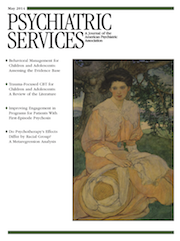New Briefs
CIHS workforce site assembles training resources for integrated care team members: Integrated care teams blend the expertise of providers from various disciplines. Team members include but are not limited to psychiatrists and other physicians, nurse practitioners, social workers, psychologists, addiction counselors, care managers, community health workers, peer support specialists, medical assistants, nurses’ aides, and representatives from community agencies. Because of cultural and clinical differences between team members, a successful collaboration, although powerful when realized, can be a challenge to establish. Special training focused on collaboration skills is critical for all team members. The Center for Integrated Health Solutions (CIHS) has created a Web site (www.integration.samhsa.gov/workforce) with links to training for various team members. For example, social workers are directed to the Integrated Healthcare Curriculum for Schools of Social Work (www.cswe.org/CentersInitiatives/DataStatistics/58020.aspx), a downloadable curriculum that introduces social work students to the practice of integrated behavioral health in primary care and develops skills in engagement, assessment, intervention planning and implementation, and practice evaluation. For addiction counselors, the CIHS workforce site links to a five-hour self-paced online course (www.thedatabank.com/dpg/423/donate.asp?formid=meetb&c=3845416) designed to help them decide whether working in a primary care setting would be a good fit. “Case to Care Management Training” (www.integration.samhsa.gov/Case_to_Care_Training_One_Pager.pdf) is a one-day course that expands the traditional case manager role from helping clients with serious mental illness change their behaviors to helping them learn to manage co-occurring general medical and mental illnesses. These and other training resources, along with a report outlining nine core competencies of effective integrated teams, are available on the CIHS workforce site. CIHS is jointly funded by the Substance Abuse and Mental Health Services Administration and the Health Resources and Services Administration.
Bazelon report highlights continued impact of ADA’s “integration mandate” for housing: A report by the Bazelon Center for Mental Health Law shows how the Americans With Disabilities Act (ADA) can continue to be an effective tool to create supported housing for individuals with mental illness. The ADA’s “integration mandate” requires states and other public entities to deliver services to individuals with disabilities in the most integrated setting appropriate to their needs. The 22-page report begins by stating, “For virtually all people with disabilities, the most integrated setting appropriate is their own apartment or home, with the supports that they need to live there.” The report’s authors acknowledge that nearly a quarter century after ADA’s passage, hundreds of thousands of individuals with disabilities remain needlessly segregated in psychiatric hospitals, nursing and board-and-care homes, and similar facilities. The political power of private industries serving individuals with disabilities in segregated settings has blocked states from developing alternatives, the report notes. The report is designed to help advocates continue to use the ADA and other legislation on the rights of people with disabilities to ensure the development of scattered-site supported housing with subsidies and individualized services. It includes a brief history of deinstitutionalization; a list of key community integration principles and related guidance issued by federal agencies; and a discussion of historical and current Olmstead settlement agreements. A Place of My Own: How the ADA Is Creating Integrated Housing Opportunities for People With Mental Illnesses can be downloaded from the Bazelon Center site (www.bazelon.org).
Kaiser brief examines financial assistance under the ACA: The ACA provides premium subsidies to people with low and middle incomes who buy insurance on their own through health insurance exchanges. Subsidies generally are available to those with incomes ranging from one to four times the poverty level ($11,490 to $45,960 for a single person and $23,550 to $94,200 for a family of four). Depending on their income, people are expected to pay 2% to 9.5% of their income toward the premium for the second-lowest-cost silver plan in their area, and the federal government covers the remainder of the cost through a tax credit. According to a new data analysis from the Kaiser Family Foundation, an estimated 83% of marketplace enrollees nationwide qualify for subsidies, ranging from 13% in the District of Columbia and 35% in Hawaii to 92% in Wyoming and 93% in Mississippi. (As the report notes, members of Congress and some of their staff obtain coverage through the D.C. exchange and are not eligible for subsidies, which explains the lower percentage there.) The take-up rate of subsidies—that is, the percentage of those eligible for a subsidy who have enrolled in an exchange—is 21% in the United States overall and ranges from 10% or less in a number of states to 32% or more in Washington, Connecticut, California, Rhode Island, and Vermont. In general, states that are running their own exchanges have higher take-up rates. In the five states with the highest take-up, 39% of those eligible for a subsidy have already enrolled in an exchange, compared with 21% in the United States as a whole. Among those qualifying for subsidies, the report estimates that the average subsidy is $2,890 per person, ranging from a low of $1,350 in D.C. and $1,780 in Utah to a high of $4,370 in Mississippi and $4,980 in Wyoming. On the basis of enrollment as of March 1, 2014, estimated annual subsidies total $10.0 billion nationwide. Over half of this amount is going to people in five states (California, Florida, North Carolina, Texas, and New York), which is related both to the size of the states and the take-up rate of subsidized enrollees. If all states were enrolling people at the rate of the five most successful states, 3.1 million more people would have qualified for subsidies—for an additional $8.6 billion. The brief is available on the health care reform section of the Kaiser site (kff.org/health-reform).



